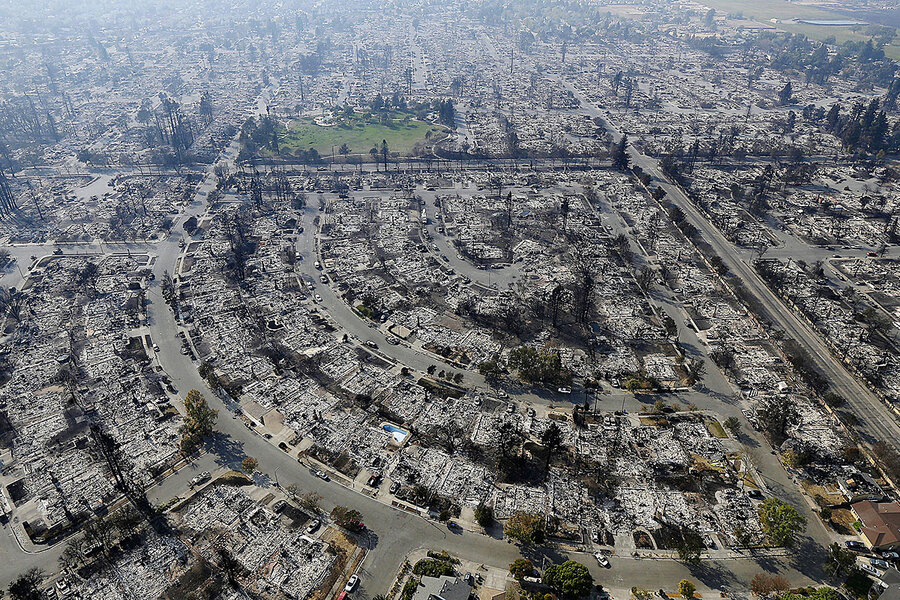After California wildfires, what survivors say they gained from loss
Loading...
| Santa Rosa, Calif.
Next week will mark 18 months since the Tubbs fire tore through Northern California’s wine country, destroying more than 5,300 homes. One was Evelyn and Keith Anderson’s house in Santa Rosa. As Ms. Anderson mends from her emotional wounds, she finds herself aware of subtle shifts in her approach to life. She savors the quiet evening hours after work and her bond with the couple’s two college-age children has deepened.
The changes illustrate a behavioral health theory called post-traumatic growth. The concept focuses on the potential for survivors of life-threatening events to emerge over time with renewed purpose and a greater appreciation of life. “There are all number of positive things that can happen as people recover from disaster,” says Dr. Carol North, a professor of psychiatry. Those changes can range from greater self-confidence to deeper spiritual beliefs.
“I take more things in stride now,” says Georgina Logue, who lost her house in the fire. The Andersons have yet to decide whether to rebuild their home, but where they once felt unmoored, they have come to regard their loss as an opportunity. Says Ms. Anderson, “There’s almost a sense of freedom now.”
Why We Wrote This
Everyone is familiar with the concept of post-traumatic stress. But there’s a less-understood phenomenon, called post-traumatic growth, that says survivors of life-threatening events can emerge over time with renewed purpose and strength.
The sorrow surges at unexpected moments. Evelyn Anderson recalls a visit to the outdoor store REI a few months ago when she noticed a jacket for sale similar to one she used to own. The coat tripped a cascade of memories of everything else she and her family lost when a wildfire destroyed their home in 2017.
The thoughts soon receded, a sign of progress from the first year after the fire, when the distress felt chronic, draining her spirit day after endless day. As more time passes, and Ms. Anderson mends from her emotional wounds, she finds herself aware of other subtle shifts in her mindset and approach to life.
She makes an effort to slow down in the evenings after work to savor the quiet hours with her husband. The already close bond she shared with the couple’s two college-age children has deepened. Her empathy has grown for those driven from their homes – by natural disasters or drought, by religious persecution or war – and she better understands the anxiety of uncertainty.
Why We Wrote This
Everyone is familiar with the concept of post-traumatic stress. But there’s a less-understood phenomenon, called post-traumatic growth, that says survivors of life-threatening events can emerge over time with renewed purpose and strength.
“What’s important has changed a lot,” says Ms. Anderson, the interim co-principal of a French-American charter school in Santa Rosa. “And the sense that we’ve come such a long way since the fire – that feels good. There’s a sense of moving forward.”
Her evolving perspective illustrates a behavioral health theory called post-traumatic growth. The concept focuses on the potential for survivors of natural disasters, mass shootings, and other life-threatening events to emerge over time with renewed purpose, gaining strength from overcoming the adversity imposed upon them.
The process of healing from psychological trauma varies by individual, and the arc of recovery can prove long, uneven, and at times, profoundly discouraging. Yet if a natural disaster exposes the vulnerability of survivors, slogging through the aftermath can uncover hidden reserves of resolve, explains Dr. Carol North, a professor of psychiatry at the University of Texas Southwestern Medical Center in Dallas.
“There are all number of positive things that can happen as people recover from disaster,” says Dr. North, who has studied the effects of trauma on survivors of Hurricane Katrina and the Sept. 11 terrorist attacks. “Those can be things like ‘I realize how many people care about me’ or ‘I realize I’m a lot stronger than I knew.’ For some people, their relationships or religious faith can get stronger.”
Next week will mark 18 months since the Tubbs fire tore through Northern California’s wine country, claiming 22 lives and razing more than 5,300 homes in and around Sonoma County, including the Andersons’ house in Santa Rosa.
The fire was one of several in fall 2017 that forced mass evacuations in the region, and thousands of people still lack permanent housing. As they attempt to restore the order of life, their internal journey could hold lessons for the residents of Paradise, California, where a wildfire in November killed 85 people and incinerated some 14,000 homes.
Ms. Anderson and her husband, Keith Anderson, an electrical engineer, moved into a rental house after the Tubbs fire. The couple has yet to decide whether to rebuild their home, but where they once felt unmoored, they have come to regard their loss as an opportunity.
“There’s almost a sense of freedom now,” she says. “We’ve realized that we can do anything.”
Time and perspective
The Tubbs fire ranks as the second-most destructive blaze in state history, behind the wildfire that wiped out much of Paradise. The sluggish pace of new housing construction in Santa Rosa has begun to pick up in the past six months. The emotional recovery of residents remains more difficult to gauge.
The demand for mental health services offers one measure of the trauma caused by the fires two years ago. A disaster crisis counseling program in Sonoma County, funded by the Federal Emergency and Management Agency (FEMA), has provided free services to more than 85,000 residents since October 2017.
Wendy Wheelwright, the program’s project manager, supervises 36 counselors who traverse the county to aid fire survivors coping with what she calls “the disaster after the disaster.” The phrase refers to the exhausting process residents face as they try to rebuild, including the almost inevitable battles with FEMA and insurance companies over disaster claims.
Many displaced homeowners have learned that the San Francisco Bay Area’s exploding housing costs will prevent them from building a similar home – or at all – on the same property. Those who opt to stay must weigh the risks of living in an area twice ravaged by fire since 1964 and in a state where the size, number, and intensity of wildfires appears on the rise.
The choices can sharpen the despair of residents as they languish between an irretrievable past and an unsettled present. “It’s not just a house and the stuff we lose,” Ms. Wheelwright says. “It’s also losing the feeling of security and the routines we have as part of our daily lives.”
The Tubbs fire reduced to ashes the Santa Rosa home where Georgina and John Logue had lived since 1984. One of their neighbors died in the blaze.
The retired couple’s insurance covered only 70 percent of their losses. They bought a smaller house soon after the fire. The space afforded them stability without alleviating their grief.
“Losing our house was almost like a death,” Ms. Logue says. “The first year was very hard and very long.”
Recent research into the resilience of crisis survivors has expanded to the realm of post-traumatic growth. The theory’s broad principles range from greater self-confidence, appreciation for life, and compassion for others to closer personal relationships and deeper spiritual beliefs.
A crucial aspect of that internal change involves the degree of hardship survivors confront as they seek to reclaim their lives. One study found that New York residents who reported severe symptoms of post-traumatic stress disorder after Hurricane Sandy showed more capacity to grow from their experience. Several studies of Hurricane Katrina survivors yielded similar results.
Behavioral health researchers emphasize that post-traumatic growth generally occurs only after people resurface from a wrenching crisis and make peace with their fate. “It’s hard for good things to happen when we’re still feeling damaged,” Dr. North says. “The positive change comes with time and perspective.”
Ms. Logue sought solace from her faith and family, including five grandchildren. In recent months, with the couple’s new home under construction, she has perceived a difference in her disposition from before the fire.
“I take more things in stride now,” she says. “It’s just more of an awareness of what’s important. I know people who are living in trailers or with family. We’re fortunate to be where we are.”
Living with purpose
Madonna Day had lived in her home for 49 years when she fled the Tubbs fire. She returned to piles of scorched rubble and the prospect of starting life over as an octogenarian.
Her visceral connection to the pastoral, Edwardian-style retreat, built in 1908, spans memories of her two late husbands, the three children she raised, and the small dairy farm she ran to produce goat cheese.
Ms. Day admits her anguish quickened her temper. She scoffed at the well-meaning sympathy of friends and groused about the first rental house her daughter, Marie-Louise Clark, found for her.
She moved into another rental home more to her liking earlier this year, and with stubborn persistence and Ms. Clark’s patient help, she has pursued plans to rebuild. Mother and daughter visited the property last week, and while the blackened landscape brought Ms. Day to tears, more light infuses her outlook compared with six months ago.
“I lost everything,” she says. “But I’ve realized I don’t need all the things I had before.” As much as the house project and family support, she ascribes the gradual lifting of her mood to a renewed devotion to visiting friends whose physical frailties leave them housebound.
“I have a very upbeat feeling when I’m with them because I’m trying to raise their spirits. That feels good because it takes my mind off my situation. It’s a way for me to feel like I can help,” she says.
Studies suggest that people who seek out contact with family, friends, and neighbors after a disaster show higher potential for post-traumatic growth. An analysis of survivors of a deadly tornado in Missouri in 2011 found that more than a third reported post-traumatic growth within 30 months of the storm. In evaluating the responses of residents, researchers concluded that “family and social networks may help individuals make sense of the traumatic experience by talking together.”
Samuel Bernier, a psychotherapist who provides individual and group counseling to fire survivors in Santa Rosa, describes creating and repairing social connections as essential to emotional recovery in a disaster’s aftermath.
“With a big wildfire, it’s basically like a refugee crisis,” he says. “People are dislocated from their homes, their neighborhoods, their communities. Coming together to talk can reduce their sense of isolation and build up their inner strength.”
Evelyn Anderson escaped her home with little more than her purse and a work laptop. She soon began attending block meetings with other displaced residents from her neighborhood. The sessions acted as a catharsis.
Early on, they shared stories of evacuation chaos, swapped insurance tips, and vented about FEMA. At a meeting two weeks ago, they talked about progress and found reasons to laugh, even as many remain in limbo.
“Being part of a group of fire survivors does provide strength,” Ms. Anderson says. “There’s a level of understanding that helps with healing.”
She never wanted to endure the trauma that the fire inflicted. She intends to always remember what she has gained from loss.
“I have more of a sense of how adrift one can be without their home, and that’s given me more of an appreciation of what it means to be living with purpose.”









